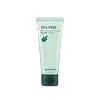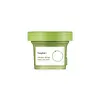What's inside
What's inside
 Key Ingredients
Key Ingredients

 Benefits
Benefits

 Concerns
Concerns

 Ingredients Side-by-side
Ingredients Side-by-side

Water
Skin ConditioningKaolin
AbrasiveDipropylene Glycol
HumectantBentonite
AbsorbentPhaseolus Angularis Seed Powder
Betaine
HumectantPropanediol
SolventGlycerin
Humectant1,2-Hexanediol
Skin ConditioningCI 77891
Cosmetic ColorantIllite
AbrasiveXanthan Gum
EmulsifyingCI 77288
Cosmetic ColorantSalvia Hispanica Seed Extract
EmollientCentella Asiatica Extract
CleansingHouttuynia Cordata Extract
Skin ConditioningCI 77492
Cosmetic ColorantCI 77499
Cosmetic ColorantMontmorillonite
AbsorbentCalcite
Skin ConditioningButylene Glycol
HumectantEthylhexylglycerin
Skin ConditioningOlea Europaea Fruit Oil
MaskingMelaleuca Alternifolia Leaf Extract
PerfumingAllantoin
Skin ConditioningLavandula Angustifolia Oil
MaskingEucalyptus Globulus Leaf Oil
PerfumingRosmarinus Officinalis Leaf Oil
MaskingCitrus Limon Peel Oil
MaskingCitrus Medica Vulgaris Peel Oil
MaskingCananga Odorata Flower Oil
MaskingAniba Rosaeodora Wood Oil
AstringentCitrus Nobilis Peel Oil
MaskingCitrus Aurantium Bergamia Fruit Oil
MaskingSalvia Sclarea Oil
MaskingEucalyptus Globulus Leaf Extract
PerfumingCitrus Aurantium Dulcis Peel Oil
MaskingCamellia Sinensis Leaf Extract
AntimicrobialPelargonium Graveolens Flower Oil
MaskingChamomilla Recutita Flower Oil
MaskingIllicium Verum Fruit/Seed Oil
MaskingCitrus Aurantium Dulcis Flower Oil
AstringentRose Flower Oil
MaskingJasminum Officinale Oil
MaskingWater, Kaolin, Dipropylene Glycol, Bentonite, Phaseolus Angularis Seed Powder, Betaine, Propanediol, Glycerin, 1,2-Hexanediol, CI 77891, Illite, Xanthan Gum, CI 77288, Salvia Hispanica Seed Extract, Centella Asiatica Extract, Houttuynia Cordata Extract, CI 77492, CI 77499, Montmorillonite, Calcite, Butylene Glycol, Ethylhexylglycerin, Olea Europaea Fruit Oil, Melaleuca Alternifolia Leaf Extract, Allantoin, Lavandula Angustifolia Oil, Eucalyptus Globulus Leaf Oil, Rosmarinus Officinalis Leaf Oil, Citrus Limon Peel Oil, Citrus Medica Vulgaris Peel Oil, Cananga Odorata Flower Oil, Aniba Rosaeodora Wood Oil, Citrus Nobilis Peel Oil, Citrus Aurantium Bergamia Fruit Oil, Salvia Sclarea Oil, Eucalyptus Globulus Leaf Extract, Citrus Aurantium Dulcis Peel Oil, Camellia Sinensis Leaf Extract, Pelargonium Graveolens Flower Oil, Chamomilla Recutita Flower Oil, Illicium Verum Fruit/Seed Oil, Citrus Aurantium Dulcis Flower Oil, Rose Flower Oil, Jasminum Officinale Oil
Water
Skin ConditioningVigna Radiata Seed Extract 11%
Skin ConditioningGlycerin
HumectantKaolin
AbrasiveBentonite
AbsorbentDiglycerin
HumectantZea Mays Starch
AbsorbentPropanediol
Solvent1,2-Hexanediol
Skin ConditioningGlyceryl Glucoside
HumectantBetaine
HumectantDipropylene Glycol
HumectantPhaseolus Radiatus Seed Powder 0.6%
Calamine
AbsorbentPotassium Cetyl Phosphate
EmulsifyingXanthan Gum
EmulsifyingHydroxyacetophenone
AntioxidantCocos Nucifera Shell Powder
AbrasiveEthylhexylglycerin
Skin ConditioningNiacinamide
SmoothingPhaseolus Radiatus Seed Extract 0.1%
Skin ConditioningPhaseolus Radiatus Extract 0.1%
Skin ConditioningOlea Europaea Fruit Oil
MaskingSodium Acrylate/Sodium Acryloyldimethyl Taurate Copolymer
Emulsion StabilisingChlorella Vulgaris Powder
Skin ConditioningPolyisobutene
Glucose
HumectantTriethoxycaprylylsilane
Disodium EDTA
Butylene Glycol
HumectantCitric Acid
BufferingAllantoin
Skin ConditioningSorbitan Oleate
EmulsifyingCaprylyl/Capryl Glucoside
CleansingAbies Sibirica Oil
MaskingRosmarinus Officinalis Leaf Oil
MaskingSalvia Sclarea Oil
MaskingPhaseolus Radiatus Sprout Extract
HumectantAnthemis Nobilis Flower Oil
MaskingHydrolyzed Extensin
Skin ConditioningJuniperus Mexicana Oil
MaskingCanadian Colloidal Clay
Skin ConditioningManicouagan Clay
AbsorbentIllite
AbrasiveChamomilla Recutita Flower Oil
MaskingMontmorillonite
AbsorbentProtease
ExfoliatingWater, Vigna Radiata Seed Extract 11%, Glycerin, Kaolin, Bentonite, Diglycerin, Zea Mays Starch, Propanediol, 1,2-Hexanediol, Glyceryl Glucoside, Betaine, Dipropylene Glycol, Phaseolus Radiatus Seed Powder 0.6%, Calamine, Potassium Cetyl Phosphate, Xanthan Gum, Hydroxyacetophenone, Cocos Nucifera Shell Powder, Ethylhexylglycerin, Niacinamide, Phaseolus Radiatus Seed Extract 0.1%, Phaseolus Radiatus Extract 0.1%, Olea Europaea Fruit Oil, Sodium Acrylate/Sodium Acryloyldimethyl Taurate Copolymer, Chlorella Vulgaris Powder, Polyisobutene, Glucose, Triethoxycaprylylsilane, Disodium EDTA, Butylene Glycol, Citric Acid, Allantoin, Sorbitan Oleate, Caprylyl/Capryl Glucoside, Abies Sibirica Oil, Rosmarinus Officinalis Leaf Oil, Salvia Sclarea Oil, Phaseolus Radiatus Sprout Extract, Anthemis Nobilis Flower Oil, Hydrolyzed Extensin, Juniperus Mexicana Oil, Canadian Colloidal Clay, Manicouagan Clay, Illite, Chamomilla Recutita Flower Oil, Montmorillonite, Protease
Ingredients Explained
These ingredients are found in both products.
Ingredients higher up in an ingredient list are typically present in a larger amount.
1,2-Hexanediol is a synthetic liquid and another multi-functional powerhouse.
It is a:
- Humectant, drawing moisture into the skin
- Emollient, helping to soften skin
- Solvent, dispersing and stabilizing formulas
- Preservative booster, enhancing the antimicrobial activity of other preservatives
Allantoin is a soothing ingredient known for its protective and moisturizingg properties. Because of this, it is often added to products with strong active ingredients.
Studies show higher concentrations of this ingredient can promote wound healing.
Though it can be derived from the comfrey plant, allantoin is produced synthetically for cosmetic products to ensure purity.
Learn more about AllantoinBentonite is an aluminium phyllosilicate clay with great absorbent properties. The name 'bentonite' comes from the area where the largest source is found: Fort Benton, Wyoming.
As a clay, bentonite is often used to absorb excess oil and provide exfoliation. It has also been shown to have some antibacterial and anti-inflammatory properties. Studies show bentonite was effective at calming dermatitis from poison ivy and in diaper dermatitis of infants. Bentonite has also been shown to act as a barrier against toxic compounds on your skin.
Sunscreens containing bentonite display higher water resistance and stay on the skin for much longer. The sunscreens containing bentonite also show higher potency and UV light absorbtion.
Bentonite is naturally created from volcanic ash and several natural weathering/hydrothermal processes.
A common usage of bentonite is removing excess protein from white wines. Bentonite contains a property of being able to absorb large amounts of protein from aqueous solutions.
Phyllosilicate clay has a structure formed by sheets.
Learn more about BentoniteBetaine is a common humectant (a substance that promotes retention of moisture). It's known to be gentle on the skin and can help balance hydration.
This ingredient is best for improving hydration and soothing irritated skin. Studies also show it helps even out skin tone.
Fun fact: Betaine is naturally created in the skin and body. The kind found within cosmetic products can be either plant-derived or synthetic.
Another name for betaine is trimethylglycine.
Learn more about BetaineButylene Glycol (or BG) is used within cosmetic products for a few different reasons:
Overall, Butylene Glycol is a safe and well-rounded ingredient that works well with other ingredients.
Though this ingredient works well with most skin types, some people with sensitive skin may experience a reaction such as allergic rashes, closed comedones, or itchiness.
Learn more about Butylene GlycolChamomilla Recutita Flower Oil comes from the chamomile flower (like the tea you drink).
Essential oils from chamomile have been found to improve wound healing due to its antimicrobial properties.
Chamomile oil can help soothe and hydrate your skin.
Learn more about Chamomilla Recutita Flower OilDipropylene Glycol is a synthetically created humectant, stabilizer, and solvent.
This ingredient helps:
Dipropylene glycol is technically an alcohol, but it belongs to the glycol family (often considered part of the ‘good’ alcohols). This means it is hydrating and gentle on skin unlike drying solvent alcohols like denatured alcohol.
As a masking agent, Dipropylene Glycol can be used to cover the smell of other ingredients. However, it does not have a scent.
Studies show Dipropylene Glycol is considered safe to use in skincare.
Learn more about Dipropylene GlycolEthylhexylglycerin (we can't pronounce this either) is commonly used as a preservative and skin softener. It is derived from glyceryl.
You might see Ethylhexylglycerin often paired with other preservatives such as phenoxyethanol. Ethylhexylglycerin has been found to increase the effectiveness of these other preservatives.
Glycerin is already naturally found in your skin. It helps moisturize and protect your skin.
A study from 2016 found glycerin to be more effective as a humectant than AHAs and hyaluronic acid.
As a humectant, it helps the skin stay hydrated by pulling moisture to your skin. The low molecular weight of glycerin allows it to pull moisture into the deeper layers of your skin.
Hydrated skin improves your skin barrier; Your skin barrier helps protect against irritants and bacteria.
Glycerin has also been found to have antimicrobial and antiviral properties. Due to these properties, glycerin is often used in wound and burn treatments.
In cosmetics, glycerin is usually derived from plants such as soybean or palm. However, it can also be sourced from animals, such as tallow or animal fat.
This ingredient is organic, colorless, odorless, and non-toxic.
Glycerin is the name for this ingredient in American English. British English uses Glycerol/Glycerine.
Learn more about GlycerinIllite is an exfoliant.
Kaolin is a clay. It is used for oil control and to help minimize pores. Like other clays, kaolin has the ability to absorb excess sebum or oil. This can help clean out pores and mattify the skin.
Some types of kaolin may have exfoliating properties. When water is added to kaolin, it becomes a paste with small abrasive particles.
Most kaolin is a white color, but may be pink/orange/red depending on where it comes from.
The name 'kaolin' comes from a Chinese village named 'Gaoling'. Kaolin clay comes from rocks rich in kaolinite. Kaolinite, the mineral, has a silicate layered structure. Kaolinite is formed from chemical weathering of aluminum siilicate minerals.
Besides skincare, kaolin is commonly used to make glossy paper, in ceramics, toothpaste, and as medicine to soothe stomach issues.
Learn more about KaolinMontmorillonite is a clay (aluminomagnesium silicate) with strong absorption properties. It has a similar pH to skin.
This clay is named after Montmorillon in France.
Learn about other types of clay, such as Kaolin, Bentonite, or Fuller's Earth.
Learn more about MontmorilloniteOlea Europaea Fruit Oil is the fixed oil obtained from the ripe fruit of the Olive. In other words - olive oil.
The primary contents of olive oil are glycerides of the fatty acids linoleic, oleic and palmitic.
Olive oil also contains antioxidants such as Vitamin E. Antioxidants may help reduce signs of aging by fighting unstable free-radical molecules. It also contains Vitamins A (retinol), D, and K.
The squalene in olive oil makes it a great emollient. Emollients help soothe and soften your skin by trapping moisture in. This makes olive oil a great skin moisturizer.
Studies show olive oil to have antibacterial and antifungal properties in low concentrations. Another study found olive oil irritated sensitive oily skin. We always recommend speaking with a professional about using this ingredient in your routine.
Due to the fatty acid content, this ingredient may not be fungal-acne safe.
Learn more about Olea Europaea Fruit OilPropanediol is an all-star ingredient. It softens, hydrates, and smooths the skin.
It’s often used to:
Propanediol is not likely to cause sensitivity and considered safe to use. It is derived from corn or petroleum with a clear color and no scent.
Learn more about PropanediolRosmarinus Officinalis Leaf Oil is oil expressed from the leaves of the rosemary plant.
Rosemary Leaf Oil is a fragrance and helps give your product a scent. If you are sensitive to irritating fragrances, this one contains camphor. Camphor has been found to irritate skin.
This oil also contains antioxidant and antimicrobial properties. As an antioxidant, it may protect you skin against damage. This can help slow down the signs of aging.
Learn more about Rosmarinus Officinalis Leaf OilSalvia Sclarea Oil is a volatile oil obtained from the Clary Sage, Salvia sclarea L., Lamiaceae
Water. It's the most common cosmetic ingredient of all. You'll usually see it at the top of ingredient lists, meaning that it makes up the largest part of the product.
So why is it so popular? Water most often acts as a solvent - this means that it helps dissolve other ingredients into the formulation.
You'll also recognize water as that liquid we all need to stay alive. If you see this, drink a glass of water. Stay hydrated!
Learn more about WaterXanthan gum is used as a stabilizer and thickener within cosmetic products. It helps give products a sticky, thick feeling - preventing them from being too runny.
On the technical side of things, xanthan gum is a polysaccharide - a combination consisting of multiple sugar molecules bonded together.
Xanthan gum is a pretty common and great ingredient. It is a natural, non-toxic, non-irritating ingredient that is also commonly used in food products.
Learn more about Xanthan Gum